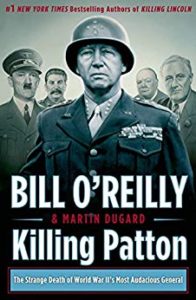
I recently read Killing Patton, one of the books in Bill O’Reilly’s Killing series. These books always talk about the death of the main person in the book’s title. They also say a lot about the times in which the book was set. George Patton’s death was one that I’ve seen the history channel talk about before, and it seemed interesting.
Prior to reading this book, I didn’t know a lot about Patton, other than he was a famous general. I also knew he was buried in Luxembourg, because I saw his grave when I went on vacation in Germany. World War II happened before my parents were even born. It’s one of those world events that is slowly receding into the mists of history. This book provides a lot of insight into that war. The section covering Patton’s death is a very small fraction of this book.
Killing Patton, in addition to discussing the general’s military genius and his insensitivity towards people with PTSD (back then known as “shell shock”) talks about other aspects of the war as well. It discusses some of the battles that led to victory in Europe, Hitler’s demise, and some of the horrific things that happened to people in the concentration camps (even after their release). It even talks a little bit about Stalin and why the Russians celebrate New Years’ with Christmas trees, even to this day.
The style of this book is similar to the other Killing books, with a close third person perspective. It sticks to the facts, while trying to bring the story to life.
If you’re interested in George Patton, World War II, or enjoy Bill O’Reilly’s other Killing books, you might want to read Killing Patton. If you’re already an expert on the European theater during World War II, this book might not bring any new information. It’s also a book solely about Patton’s death and it’s associated conspiracy theories. If you’re looking for a book that pushes conspiracy theories, O’Reilly’s books are not for you. I enjoyed it, and maybe you will as well.
